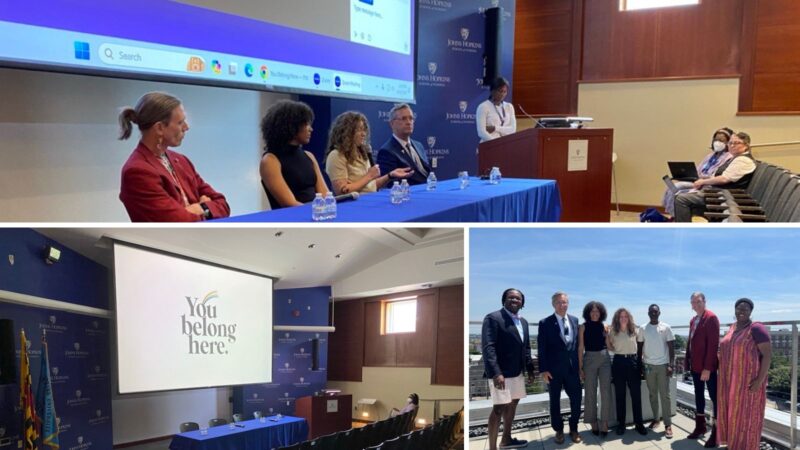We drive 45 minutes each way, from the hospital in Port-au-Prince to Gressier. It has been an eye-opening experience, since prior to this, I have only been between the hospital and hotel, a 5-minute drive.
* Everyone is sleeping outside. Everyone. Those who have their homes flattened, those whose homes have cracks, and all others. Everyone is afraid to sleep or work in any of the buildings until an official government engineer inspects a building and finds it safe to re-inhabit. This affects Port-Au-Prince and all the towns we passed on the way to Gressier. I suspect it affects the third of the country most heavily hit by the earthquake.
 * Sleeping outside means that people are gathered together in tents to sleep. Tents are mostly sticks lashed together with sheets or towels or shirts stretched across. Sometimes, cardboard or tin or other materials are added to the mix. The tents are in large areas, such as parks or open spaces, all packed together. They are also pitched in small areas, such as the median strip of highways. Daily life goes on in front and within these tent areas — people wash their clothes and their children, prepare their meals and eat. There is little privacy, a luxury here.
* Sleeping outside means that people are gathered together in tents to sleep. Tents are mostly sticks lashed together with sheets or towels or shirts stretched across. Sometimes, cardboard or tin or other materials are added to the mix. The tents are in large areas, such as parks or open spaces, all packed together. They are also pitched in small areas, such as the median strip of highways. Daily life goes on in front and within these tent areas — people wash their clothes and their children, prepare their meals and eat. There is little privacy, a luxury here.
* There seem to be increasing numbers of sturdy tents from NGOs. “Shelterbox” provides beautiful tents for families, and I am seeing more and more of them in some parts of Port-au-Prince. That is a great thing, because many fear the rainy season and the difficulties it will cause people who are in flimsy dirt-floor tents.
* The condition of the roads, never very stellar in Haiti, is getting worse each day. As we drive to Gressier, our driver and translator exclaim periodically when we encounter a new split or depression in the road, probably caused by the frequent aftershocks. Says translator Denise, “the earthquake crashed the road more, and cut it worse.”
* An increasing problem: trash. Trash pick-up seems to be on hold as any large trucks and resources are dealing with the bigger issue of earthquake rubble. Meanwhile, people have nowhere to put the mounds of trash — plastic bottles, cartons, wrappers, etc. Haitians tend to use and reuse whatever they can, so there is much less trash per person here than in the U.S., but what is here is simply adding up and combining with the dirty water in the streets. We saw one whole street with a continuous mound of trash 6 feet wide and 4 feet high that went on and on. People climbed over it to get to the other side of the street. Children played along the edge, a public health problem brewing. This also makes driving difficult, as you have to weave around the trash piles, as well as slow down for the new cracks in the road and avoid other rubble and wires. (There was one tangle of wires hanging across a street we routinely travel. One day last week, it had dipped so low that there was a spark when our bus went under it and didn’t quite clear. The next day, the wires were removed, thank goodness.)
people have nowhere to put the mounds of trash — plastic bottles, cartons, wrappers, etc. Haitians tend to use and reuse whatever they can, so there is much less trash per person here than in the U.S., but what is here is simply adding up and combining with the dirty water in the streets. We saw one whole street with a continuous mound of trash 6 feet wide and 4 feet high that went on and on. People climbed over it to get to the other side of the street. Children played along the edge, a public health problem brewing. This also makes driving difficult, as you have to weave around the trash piles, as well as slow down for the new cracks in the road and avoid other rubble and wires. (There was one tangle of wires hanging across a street we routinely travel. One day last week, it had dipped so low that there was a spark when our bus went under it and didn’t quite clear. The next day, the wires were removed, thank goodness.)
* Clean-up crews of citizens have taken to the street. Men and women, young and old. We saw hundreds with blue T-shirts, armed with shovels and brooms and wearing masks to protect their lungs from the thick dust that is in the air. By the end of the day, there was a visible improvement in the look of some neighborhoods. These crews are dealing with the small jobs along the side of the road and the walkways. These folks are doing all the work by hand. I have heard that this effort is funded by the UN or an NGO, but am not sure exactly who or what. Certainly someone has provided the shirts. Bigger machinery must come to remove the huge concrete slabs and chunks of concrete bricks from destroyed buildings.
* Crushed buildings seem fair game for scavengers. In these circumstances, people are struggling to survive, and they are willing to dig through rubble to pick up pieces of wire, wood, and other items that they will reuse.
 * Food distribution is a tricky business. We pass one area where the UN and U.S. soldiers stand a few feet apart in a long line to provide security as the distribution occurs. Some programs are giving the food to the women to bring home to families. Once, there was a brewing protest — it seemed people didn’t like the method of distribution.
* Food distribution is a tricky business. We pass one area where the UN and U.S. soldiers stand a few feet apart in a long line to provide security as the distribution occurs. Some programs are giving the food to the women to bring home to families. Once, there was a brewing protest — it seemed people didn’t like the method of distribution.
* Generally, a sort of daily life has somewhat returned. People are seen walking along the street, moving their wares to sell, bringing home food, children playing, etc. The streets we have seen are mostly quiet. There is no sense of violence or lack of safety that I have observed. One exception is when a foreigner sticks a camera out the window to snap a photo of people bathing or the tent camps, etc. Then there is usually an angry one or two people who yell in protest. Understandable.




